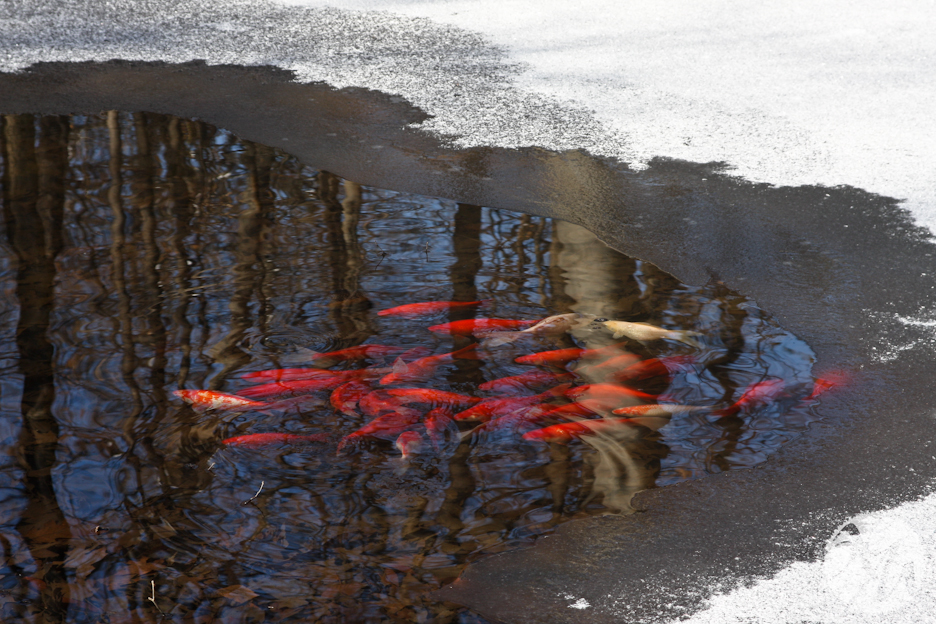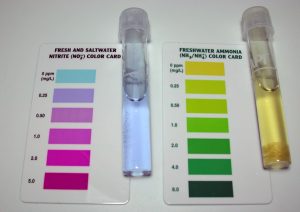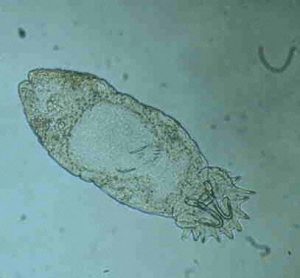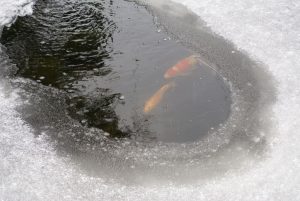Warm Winter Days and the Dangers they Pose to Your Koi
During winter, warm weather is more dangerous to your fish than freezing temperatures.
For those of you living in temperate climates (ones that experience four seasons: spring, summer, winter, and fall), this time of year might bring about some short periods (2-4 days) of warm weather. For example, in Pennsylvania, the weather forecasts are calling for air temperatures to go from the 30s to the 50s for the next three days before returning to our normal winter temps of 20s and 30s. Some of you might think this is great news! The ponds will thaw out and your fish may even start perking up and swimming around. A few warm days will do them good right? WRONG.

Sudden warm weather in late winter/early spring pose a huge threat to your Koi for reasons that are a bit complicated.
The first problem: Ammonia.
Ammonia, the toxic chemical produced by the fish and by decaying material in your pond, is normally processed by the nitrifying bacteria in your biofilter and converted into less toxic chemicals. However, in winter the cold causes this biofiltration to stop by killing some of the nitrifying bacteria and forcing the rest to go dormant. Whether you run your filter or not, your biofilter doesn’t remove the ammonia in winter (at least not fast enough to really make a difference). While many people might test their pond’s ammonia levels diligently in summer, very few Koi-keepers continue to test their water in winter. This is usually not a problem because even though it’s not being removed as it normally would in summer, ammonia is much less toxic to your fish at lower temperatures. In fact, in water below 45 degrees F, ammonia is harmless to your fish. So even if there is ammonia in your pond in winter (and there usually is since your biofilter’s not removing it), as long as the water’s cold enough, it can’t hurt your fish.
HOWEVER, if the water temperature gets above 45, perhaps due to a few sunny days with air temps in the 50s, any ammonia present in the pond becomes toxic. And the higher the water temps get, the more toxic the ammonia is to your fish. For example: an ammonia reading of .25ppm won’t hurt your fish if the water temp is below 45, but it will hurt your fish more and more as the water gets warmer than 45.
Another problem is that during warm spells, your fish become more active and produce more ammonia. Their bodies respond to the warmth by speeding up their metabolisms slightly: they start “breathing” more rapidly, and their digestion systems start moving a little faster. Like the fish, the bacteria in the pond also become more active and some start feeding on any organics in the pond (ie the process of decomposition). All of these processes increase ammonia production.
So not only is ammonia becoming more toxic as the water warms, but more of it is being produced in the pond, and almost none is being removed by the dormant biofilter! Triple wammy.
In short: if the water temp in your pond gets above 45, YOU NEED TO TEST YOUR WATER. Test like you would in summer: for ammonia, nitrite, and kH, and fix any of these that are at out of wack (ammonia and nitrite should be 0, your kH should be at least 140 ppm) just like you would in summer. If your ammonia and nitrite are zero and your kH is at least 140ppm, you can sit back and relax for the time being. Just keep testing regularly (even daily) for as long as the water temp is above 45. And again, if the water temp is below 45, you don’t have to worry even if you do have ammonia. It can’t hurt your fish at those low water temps.
For those of you who need a refresher on how to “fix” your water quality, refer to The Science of Water article.

Problem 2: Bad bugs become active in warm weather.
Like your fish, any parasites or pathogens (the bad bugs) that were dormant in your pond all winter will suddenly become active when the water warms. This is why it’s important to perform a fall cleanout of your whole pond whenever possible. Dirt and muck harbor parasites. If you don’t get rid of the muck before winter, those bugs go dormant with the fish until the weather warms again. Then as soon as warm weather hits, they “wake up” and attack your fish.
Parasite problems are much harder to deal with in winter because many treatments don’t work at low temperatures. In fact, the only option for treating parasites in winter (without removing the fish from the pond, bringing them inside, and treating them in a holding tank) is to bring the salt level up to .3% (or sometimes higher) and hope for the best.

Problem 3: Your fish are already cold stressed.
During winter, your fish’s immune systems are reduced along with all their other metabolic processes. They’re conserving all possible energy for the most basic bodily functions: keeping the gills, heart, and brain working in the cold. This means they’re weak and vulnerable to any additional sources of stress, like poor (or even marginally poor) water quality and parasites/pathogens. In this weakened state, they can’t adapt to any additional stress, so suddenly certain factors that wouldn’t affect them very much in summer (like a minor parasite infestation for example) can be leather in winter.
Even if the weather warms for a few days, the fish’s immunity will remain reduced. It takes several weeks for the fish’s body to acclimate to warmer temperatures and for its immunity to recover enough to let it deal with external stress.

In CONCLUSION:
During winter warm snaps your fish are weak when the bad bugs are strong and when water quality (specifically ammonia) is becoming more dangerous. During these periods, you need to watch your water quality and your fish like a hawk. If you know your area is in for a few warm days, you need to test your water and keep an eye out for any abnormal behaviors. This last part is very tricky because the fish are still so sluggish from the cold. If you detect ammonia and your water temp is above 45, you need to add ammonia binder (we use Ultimate Water Conditioner) to detoxify it until the water temps drop again or until the ammonia drops to a safe level (0). Keep in mind, a single dose of Ultimate detoxifies up to 1ppm ammonia for 3 days. During those three days, you might still see ammonia on your test results, but don’t worry, it can’t hurt your fish during that time. If you add Ultimate and three full days later you still detect ammonia, you’ll have to add another dose. If you observe nitrite, add salt just like you would in summer. If your kH is below 140ppm (it needs to 100ppm at the very least), add the appropriate amount of baking soda just like you would in summer. If you start seeing evidence of parasites or pathogens: wounds, white fuzz, fish flashing or laying over, or hanging/ gasping at the surface, immediately bring the salt in the pond up to .3%.
All these things are meant to reduce any and all external stress on the fish, since they’re weak from the cold, and any additional stress could easily push them over the edge and kill them.
We’ve already had a number of people contact us for help with these exact problems: fish losses and health problems following unseasonably warm periods. By the time we were contacted, the situations had reached emergency-level and these people were losing fish fast. Don’t wait until after the warm weather has come and gone before taking action. By then the damage will already have been done.
It’s easy for Koi keepers to get complacent in winter, but don’t let your guard down. Your diligence is the only thing that will save your fish, especially during warm snaps.
Written by Chris OBrien, Hanover Koi Farms. ALL RIGHTS RESERVED BY HANOVER KOI FARMS, COPYRIGHT © 2017